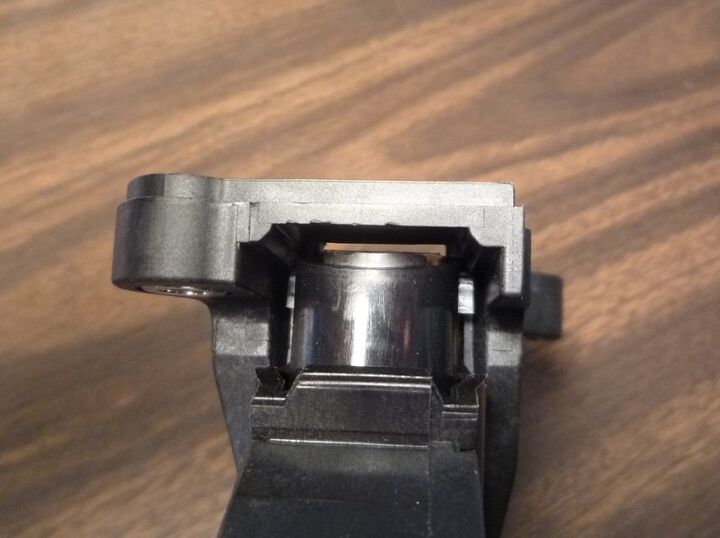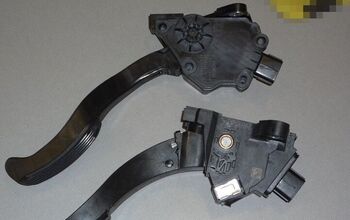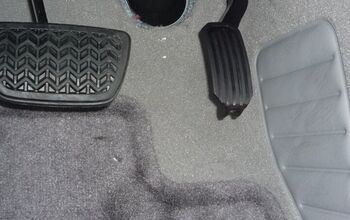Toyota Gas Pedal Fix Simulated: Friction Reduced, But By Too Much?

Update: a portal to all of TTAC’s articles on the subject of Toyota gas pedals is here:
We’ve taken it apart, explained Toyota’s intended fix, and now we’ve replicated the “fix” to see what effect it has. It works, but does it work too well?
In the photo above, the two friction teeth are shown in their operating position before the “fix”. One can easily see their pivot axle sticking out to both sides, in a lighter gray color, just where the friction unit protruded from the housing. The other end of this friction unit is the retainer for the return spring, and this is what creates the pressure on the friction teeth.
The second picture (above) shows the other end of this unit. The round end in the middle of the unit is where the coil spring is retained. The gap as shown in this picture is where the metal spacer would go. It would change the fulcrum angle, and the amount of pressure that the spring would exert on the friction teeth.
In the third picture (above) we have inserted a 1/8″ thick screwdriver shank to simulate a spacer in this area. We don’t know yet what thickness the Toyota space will have, so this is an arbitrary guess to see the effect. The amount of friction was substantially reduced by this increase in the gap, and the change in the fulcrum angle of the friction bar unit. We were not able to actually install the unit in a car to see how it would feel, but the change in feel was very noticeable to the hand.
As we’ve explained in the prior post, the balance of friction to the control spring is what creates a stable, yet safe pedal assembly. By reducing the friction, the pedal will feel “less stable”, and it might be more difficult to maintain a steady throttle opening. The perceived pressure felt by the foot will also be greater. The degree of this affect will of course depend on the thickness of the spacer Toyota specifies.
Undoubtedly, this fix will profoundly reduce the likelihood or possibility of the pedal being stuck or slow to return. But the trade off may not be immaterial. Undoubtedly, Toyota’s intended degree of friction will be compromised by this fix, to one degree or another. And drivers may find the fix unpleasant or uncomfortable, also to some degree or another. Clearly, this fix is a band aid to fix the intrinsic limitations of this design. We will be taking a closer look at the Denso pedal next to see how their design is different.
Update: The final article in this series compares the two pedals (CTS and Denso), and makes a recommendation. Link here.

More by Paul Niedermeyer
Latest Car Reviews
Read moreLatest Product Reviews
Read moreRecent Comments
- Wjtinfwb Rivaled only by the Prowler and Thunderbird as retro vehicles that missed the mark... by a mile.
- Ravenuer Haven't seen one of these in years! Forgot they existed.
- Pig_Iron I one of those weirdos who liked these.
- SCE to AUX Inflation adjusted $79k today (!), so I guess $28k is a bargain....This is another retro car that was trying too hard, but it is very nice.
- EngineerfromBaja_1990 It might provide an edge in city driving but from what I've read elsewhere the Hybrid trucks are 600 lbs to 700 lbs heavier than the gas only trucks. That translates to a curb weight of around 5000 lbs which is not uncommon for a full size truck.And a test drive suggested the Hybrid is not quicker than the gas only trucks. So it looks like the Hybrid powertrain is pretty much compensating in power for all that added weight while not providing significant fuel savings. Not what many would expect after shelling out an extra $5K - $7K for the next step up in power.





































Comments
Join the conversation
Does anyone know if this fix affects accelleration? My 2009 5 speed manual(not fixed) was much quicker than my 2010 5 speed manual.
The 2009 had 28k on it. The 2010 has 1700. The pickup in the higher gears is no way near the old one(which was unfortunately totaled in an accident).